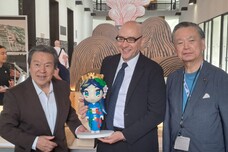The results of a workshop that began in 2014 exploring what Italy's capital might look like in ten years' time are on display at MAXXI.
The project was inspired by Rome Interrupted, a 1978 show
in which 12 well-known architects were asked to imagine a future
Rome.
This time around, the task of using installations,
drawings, videos and design to imagine the future city was
entrusted to architecture and landscape design students from 25
universities - 12 Italian and 13 foreign ones.
The University of Pennsylvania thought up a project called
Renaissance Ecology for the Olgiata-La Storta district, using
water as a starting point.
Columbia University in New York concentrated on the influx
of pilgrims for the Jubilee in the Rome-Civitavecchia area while
Princeton contributed a Sculpture Park with recycled materials.
Rome's La Sapienza University designed a new waterfront,
while the University of Palermo created a project titled
Re-Forming Rome, centered on the EUR district.
"While 20 years ago everyone focused on the services that a
city should provide, today the focus is on housing quality,
landscapes, greenery and accessibility," Ciorra said.
With a new emphasis on outlying districts, possible new
urban landscapes are envisioned, even in areas as far from the
city's historic center as Corviale and Tor Bellamonaca.
Areas such as La Borghesiana, meanwhile, change entirely -
with existing homes replaced by ones designed by well-known
architects.
"What came through is that it is not as important to add
beauty to areas in which it can already be found, as it is to do
so where the potential lies," Ciorra explained.
"Architectural culture has much to say about cities, and
there are many ways to do so in a more innovative manner," he
said.
The exhibit titled Rome 20-25 - New Life Cycles for the
Metropolis opened on Saturday and will run through January 17.
ALL RIGHTS RESERVED © Copyright ANSA











